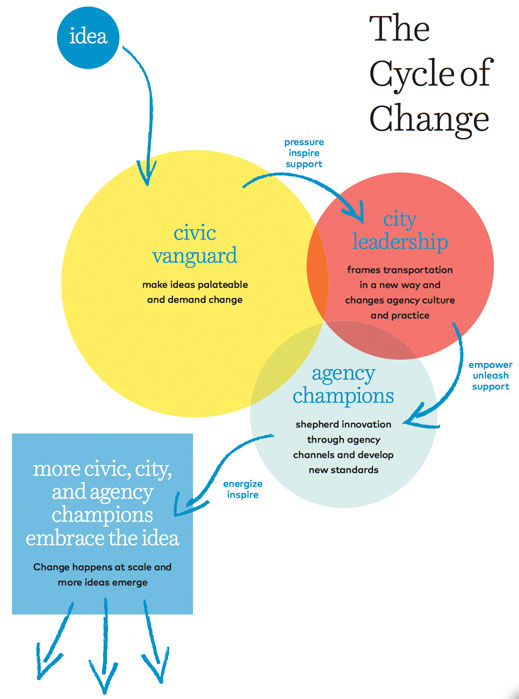
How did Portland get to be a national model for sustainable transportation and walkable development? Yes, Mayor Neil Goldschmidt stopped the Mount Hood Freeway from being built in 1974 and began negotiations that eventually led to the implementation of the urban growth boundary. But Goldschmidt didn’t do it alone.
Grassroots activists from a group called Sensible Transportation Options for People (STOP) -- which included Goldschmidt’s chief of staff when he was city commissioner -- helped him get elected and formed the ideas and policy proposals he embraced as mayor. Goldschmidt, in turn, appointed reformers to key posts in his administration.
Look at other cities that are moving beyond the 20th Century legacy of cars-first planning, and odds are you'll come across a similar story of grassroots activism merging with political power. In a new report, "A People's History of Recent Urban Transportation Innovation," TransitCenter’s Shin-pei Tsay tells those stories in six cities.
The Portland story is exceptional in that the state of Oregon worked with the city in the 1970s as a close partner on land use and transportation policy, helping to build the region's light rail system. But even without state cooperation, cities around the country are showing the way toward a more multi-modal, less car-dependent future. And as in Portland, this progress can be traced to the links between advocates and government.
Take a more recent example: New York’s street transformations under Mayor Michael Bloomberg. When people think of changes like the pedestrianization of Times Square and the construction of protected bike lanes, they think of Bloomberg and Transportation Commissioner Janette Sadik-Khan -- and for good reason. But these leaders also had the benefit of a deep and increasingly sophisticated advocacy scene, exemplified by Transportation Alternatives, with its roots stretching back to the early 1970s -- as well as groups like the Tri-State Transportation Campaign and the Regional Plan Association (and new arrivals like, ahem, Streetsblog).
At NYC DOT, Sadik-Khan drew from the ranks of the city's advocacy organizations, appointing people like Jon Orcutt, former executive director of TA and Tri-State, and Andy Wiley-Schwartz, formerly of Project for Public Spaces, to leadership positions. The new directive from the top also energized agency staff, mobilizing the talent that DOT already had at its disposal.
That, in a nutshell, is what TransitCenter calls the "cycle of change," as illustrated above. The ideas of grassroots advocates inspire a bold mayor and transportation agency head, who create a sense of purpose and urgency that shakes up agency culture, bringing plans from vision to reality in a short timeframe. By quickly delivering tangible results, innovators in government show the public what it means to move the city away from car-centric design and toward streets where people can gather in public and get around without driving.
Tsay shows how various cities have employed this strategy -- old cities like New York, Pittsburgh, and Chicago, with walkable street grids, and newer cities like Charlotte, Portland, and Denver that grew on an automobile-based model.
And that’s what makes the pattern of change described by TransitCenter so exciting. While the existing built environment can create conditions that are more or less favorable for transforming streets, in the end you can make change happen anywhere. It's the human factors that are actually decisive.





